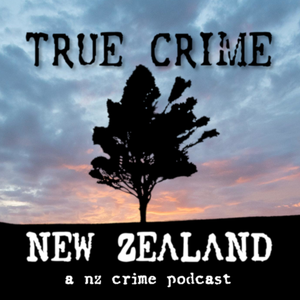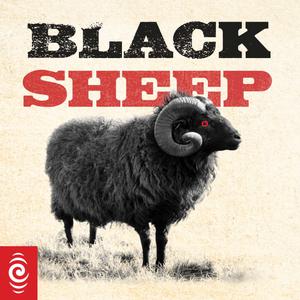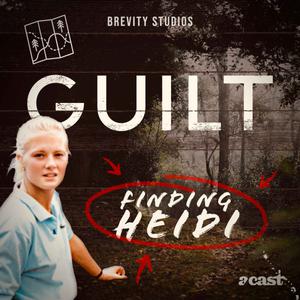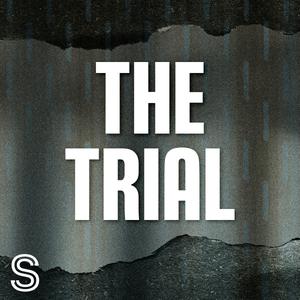
True Crime New Zealand (NZ)
True Crime New Zealand
True Crime New Zealand is a kiwi based true crime podcast. It is storytelling based with no opinion, just facts. We are trying to give the big picture of these crimes with context as well as investigating what happened subsequently and how the crime affected the wider community of NZ. www.truecrimenz.com
- 21 minutes 3 secondsCase 36: The Iceman
CALIFORNIA. USA. The drug that goes by many names, coke, blow, snow, has addictive properties. Use of cocaine induces tolerance to the effects and addicts that withdraw from the drug experience fatigue, depression, decreased libido and a decreased ability to feel pleasure. The drug also causes around 7,300 deaths annually.
With that, the stage is set for one of the strangest stories involving New Zealand, a tale that takes us from the South Island of Aotearoa where 1.2 million people call home to California in the United States of America where almost 40 million reside.
This is the disturbing and tragic case of The Iceman.
Visit www.truecrimenz.com for more information on this case including sources and credits.
23 April 2024, 9:13 pm - 41 minutes 17 secondsCase 35: The RSA Murders
The Royal New Zealand Returned and Services Association, better known simply as the RSA was first established in New Zealand on the 28th of April 1916 by veteran of the First World War Donald Simson.
The RSA is a registered charity that raises money to “provide support and comfort for service men and women and their families”. In 1921, the RSA successfully campaigned for ANZAC Day (the 25th of April) to become a public holiday.
However, there is one dark, horrifying moment in the history of the RSA, that would see the organisation the victim of one of the most cruel and depraved acts of violence in NZ’s history.
This savage, vicious crime took place only seventeen days before Christmas in December 2001 and resulted in the longest prison sentence in the annals of New Zealand. The events of that day went down in history as The RSA Murders.
Visit www.truecrimenz.com for more information on this case including sources and credits.
18 January 2024, 11:07 pm - 19 minutes 8 secondsTALES II: Bloody Friday
On the 9th of June 1978, natives of the Southland city of Invercargill in the South Island of New Zealand were treated to a curious sight, 1,300 ewes (female sheep) wandering confused around Invercargill’s main shopping district.
The confused sheep created chaos as they dashed across roads making traffic come to a standstill, chewed on the local shrubbery and ran into shops looking for safety. But why was this happening? Who set these poor critters loose?
Visit www.truecrimenz.com for more information on this case including sources and credits.
10 October 2023, 4:09 am - 34 minutes 37 secondsINVESTIGATES III: Psychopathy
Psychopathy is no longer a diagnosis in the Diagnostic and Statistical Manual of Mental Disorders as of the third edition. Rather the diagnosis would be antisocial personality disorder with psychopathic traits. These psychopathic traits are characterised by “a lack of anxiety or fear and by a bold interpersonal style that may mask maladaptive behaviours”, e.g. not adjusting adequately or appropriately to certain environments or situations.
Psychopathic traits are assessed using a variety of measurement tools, most famously Robert D. Hare’s Psychopathy Checklist (PCL-R), brought to the mainstream by author Jon Ronson in his book The Psychopath Test. Dr Hare’s checklist is a list of 20 traits which the assessed is scored on a three-point scale, for example, item 6 is lack of remorse or guilt and the recipient is assessed, giving a grade of 0 for no match, 1 for a partial match or 2 for a good match. If someone scores above 30 on the checklist, they are considered to have psychopathic traits, for instance, serial killer/serial rapist Ted Bundy was evaluated at 39/40.
Visit www.truecrimenz.com for more information on this case including sources and credits.
15 July 2023, 10:02 pm - 28 minutes 8 secondsCase 34: Phyllis Symons
HATAITAI. WELLINGTON. Construction on, what would become, Mount Victoria Tunnel began in December 1929 and was estimated to take 15 months and cost around £132,000 (approximately $16,000,000 today).
Two teams of diggers began on each side of the mountain and began tunnelling through. The initial breakthrough occurred on the 31st of May 1930, six months into construction.
Construction of the tunnel continued into the next year. However, sometime in early July 1931, construction on the tunnel was halted. The workers were contacted by police to cease work on the project.
Over the next three days, over 100 police and relief workers sifted through over 2,000 tons of rock and soil from the excavation. They were searching for something, but what were they searching for, who were they searching for?
Visit www.truecrimenz.com for more information on this case including sources and credits.
2 June 2023, 5:39 am - 32 minutes 2 secondsCase 33: Waikino School Shooting
WAIKINO. WAIKATO. 19th of October 1923. 10 am. The Headmaster of Waikino School Robert Theodore Reid was in the teacher's room, perhaps going over some reports, perhaps grading some papers. The classrooms were full of children, maybe learning English, a bit of maths, or even history and undoubtedly looking forward to the morning break only half an hour away.
The Headmaster Robert Reid had brought his dog Pax (a brown and white setter) with him to work, as he had done many times before. Pax spent the day in the school’s front yard, presumably sleeping most of the daylight away, as Pax seldom made a fuss.
However, as the clock ticked over to 10.10 am, Pax began barking loudly. Curious about what had caught the canine’s attention, Robert arose from his desk and wandered through the entrance to the front door. He opened the door to see a man in his 50s, 6 feet tall, tanned and sporting a small moustache approaching the school. As the man got closer to the entrance he announced his hideous intentions to Headmaster Robert Reid, “I’m here for revenge!”.
Visit www.truecrimenz.com for more information on this case including sources and credits.
3 March 2023, 9:33 pm - 36 minutes 8 secondsCase 32: The Newlands Baby Farmer (PART II)
NEWLANDS. WELLINGTON. Hugo Lupi was born sometime in the late 1800s possibly in Cairo, Egypt, to an Italian family. Hugo immigrated to New Zealand in 1912 and eventually settled in the South Island city of Dunedin. While in the Land of the Long White Cloud, Hugo became a sailor, before giving up the sea life to become a pie-shop proprietor.
Hugo Lupi was married, it is unclear when exactly he ‘tied the knot’ but it is probable it was sometime after he arrived in New Zealand in 1912 as it would seem he had his first child to his wife in the late 1910s.
However, Hugo began employing a woman by the name of Lily Lister sometime around Christmas 1921. The twosome began an affair.
In April 1922, Hugo Lupi left Dunedin and moved to the Wellington suburb of Island Bay with his wife and children, leaving his mistress behind.
It would seem that Hugo found employment as a fisherman in the new location but also did some carpentry work on the side. This is where he met a man who would become important to his life. Hugo had helped the man build a house in Island Bay sometime between April and June of 1922. Hugo received no payment for his help as it was understood that the man would help him build his own home at a later date as compensation. This is where Hugo got to know the man a little bit, including that he ran a specialist health business that ‘helped’ women ‘in the family way’.
In June 1922, Lily Lister joined Hugo in Wellington where he found her a job at a cafe on Willis Street in central Wellington. Although, Hugo was surprised to find out she was also approximately four months pregnant with his child.
This is when Hugo Lupi remembered the man he helped build the house with earlier in the year, the man with the specialist business in helping women ‘up the duff’, Daniel Richard Cooper.
Visit www.truecrimenz.com for more information on this case including sources and credits.
11 January 2023, 4:28 am - 30 minutes 46 secondsCase 32: The Newlands Baby Farmer (PART I)
NEWLANDS. WELLINGTON. In the 1800s to early 1920s, there was another, more controversial, type of farming going on, baby farming. Baby farming is the historical practice of accepting custody of an infant or child in exchange for payment. This was usually due to the child being born ‘illegitimate’ (meaning the child was born outside of a marriage, also known as bastardy) and the social stigma that it carried on the mother.
Some baby farmers ‘adopted’ children for lump-sum payments, while others cared for infants for periodic payments. However, in the case of a lump-sum adoption, it was more profitable for the baby farmers if the child was no longer around, as the sum would not cover the care for the child for long. In these cases, the child was sometimes adopted out to other families, and in other cases, the child simply died due to unsanitary and subpar living conditions. However, finally and most sinister, occasionally the baby farmer would commit the most heinous of acts and murder the child; pocketing the adoption fee.
These acts came to light most infamously when English serial killer and baby farmer Amelia Dyer dubbed the Ogress of Reading was officially tried and hanged in 1896 for intentionally killing six children for profit but it is estimated the real number of child deaths she was responsible for was closer to 400.
New Zealand had its own baby farmer scandal late in the 1800s when Minnie Dean was tried and hanged for the murder of three children in 1895.
However, in the early 1920s, baby farming became a topic of controversy once more within NZ as a new scandal gripped the public. With headlines splattered over the NZ Truth newspaper such as “The Newlands Horror”, “A Gruesome Discovery” and “The Massacre of the Innocents”, the public was enraptured yet horrified with what was being uncovered. The case would go on to become one of NZ’s most discussed and pondered tragedies of the 1920s. This is the story of The Newlands Baby Farmer.
Visit www.truecrimenz.com for more information on this case including sources and credits.
25 November 2022, 9:41 pm - 6 minutes 17 secondsTCNZ PODCAST UPDATE V
Hello friends,
Jessica here from True Crime NZ. This is a bit of a different podcast today, just to update you on some changes that have been happening in our lives and the future of the podcast.
8 November 2022, 1:07 am - 34 minutes 52 secondsCase 31: Christchurch House of Horrors (PART II)
CHRISTCHURCH. CANTERBURY. Thursday. 25th of September 2008. Some time between 11 am and 12.30 pm. 32-year-old Jason Somerville is home alone at his house, 312 Wainoni Road, on the corner of Hampshire Street and Wainoni Road in the Christchurch suburb of Aranui, his wife Rebecca Chamberlain was out and about.
“I was outside [chopping] some wood, came in to get a drink, someone was knocking at the front door. It was her…”. ‘Her’ was 28-year-old Tisha Lowry wearing a Chicago Bulls jacket and jeans who had just walked home from the nearby Bower Tavern. It would seem that Tisha had been to Jason’s house previously (she lived only two doors away with her grandfather), what she had come over for this day is unknown.
Visit www.truecrimenz.com for more information on this case including sources and credits.
29 September 2022, 8:05 pm - 28 minutes 55 secondsCase 31: Christchurch House of Horrors (PART I)
CHRISTCHURCH. CANTERBURY. Within the eastern suburbs of Christchurch, on the South Island of New Zealand, you will find Aranui. Originally called Flemington (after one time resident of the area Jubal Fleming), Aranui (a Māori word meaning great path) was officially established in 1912.
Found in the middle of Aranui is Hampshire Street, dubbed by many “the worst street in Christchurch”. During the 1990s, Hampshire Street was infamous for many instances of violent crime including a 13-year-old boy who was shot by his best friend, a fish and chips shop being firebombed and many occurrences of teenagers being stabbed.
In the 2000s, Hampshire Street improved its standing in Aranui, mostly with the help of the Aranui Community Trust and a Labour government that helped revitalise state housing areas. However, Hampshire Street still saw its fair share of violent crime.
Of those crimes, none are more infamous than the depravity that took place in the house on the corner of Hampshire Street and Wainoni Road, between the years 2008 and 2009. The debaucherous, degenerate and depraved crimes shocked, not only the residents of Aranui, or the citizens of New Zealand but the world at large.
This is the tale of that wickedness, an account of the folk that frequented the house at the corner of Hampshire Street and Wainoni Road, the story of the building that forever became known as The Christchurch House of Horrors.
Visit www.truecrimenz.com for more information on this case including sources and credits.
28 August 2022, 3:57 am - More Episodes? Get the App
Your feedback is valuable to us. Should you encounter any bugs, glitches, lack of functionality or other problems, please email us on [email protected] or join Moon.FM Telegram Group where you can talk directly to the dev team who are happy to answer any queries.
 Black Sheep
Black Sheep
 A Moment In Crime
A Moment In Crime
 The Long Read from Stuff
The Long Read from Stuff
 GUILT
GUILT
 The Trial
The Trial
 The Boy in the Water
The Boy in the Water